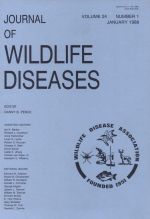In northern California, antibodies to Borrelia burgdorferi were detected in 58 of 73 (79%), and spirochetemias in one of 26 (4%) black-tailed jackrabbits (Lepus californicus californicus), by indirect and direct immunofluorescence, respectively. Five species of ticks (Dermacentor occidentalis, D. parumapertus, Ixodes neotomae, I. pacificus, and Haemaphysalis leporispalustris) were collected from rabbits. Two of these species of ticks were found to contain spirochetes; two of 10 (20%) I. neotomae and two of 174 (1%) H. leporispalustris. A strain of B. burgdorferi was recovered from I. neotomae. One infected H. leporispalustris female passed spirochetes via eggs to about 67% of her progeny. The widespread distribution of the black-tailed jackrabbit, its infestation by at least four ticks (D. occidentalis, D. parumapertus, I. neotomae, and I. pacificus) known to be infected naturally with B. burgdorferi, and the high prevalence of spirochetal antibody in this lagomorph suggest that it might be useful as a sentinel for surveillance of Lyme borreliosis. Spirochetes were detected in 15% of 40 Columbian black-tailed deer (Odocoileus hemionus columbianus) by direct immunofluorescence bound with a Borrelia -specific monoclonal antibody (H9724), but not with a monoclonal antibody (H5332) specific for B. burgdorferi. The geographical overlap of different borreliae in ticks that bite wildlife such as deer may confound spirochetal serosurveys, and underscores the need for more specific serologic tests than those currently available.
How to translate text using browser tools
1 January 1988
SPIROCHETES IN MAMMALS AND TICKS (ACARI: IXODIDAE) FROM A FOCUS OF LYME BORRELIOSIS IN CALIFORNIA
Robert S. Lane,
Willy Burgdorfer

Journal of Wildlife Diseases
Vol. 24 • No. 1
January 1988
Vol. 24 • No. 1
January 1988
Borrelia burgdorferi
deer
jackrabbits
Lyme borreliosis
natural infections
Spirochetes
ticks




